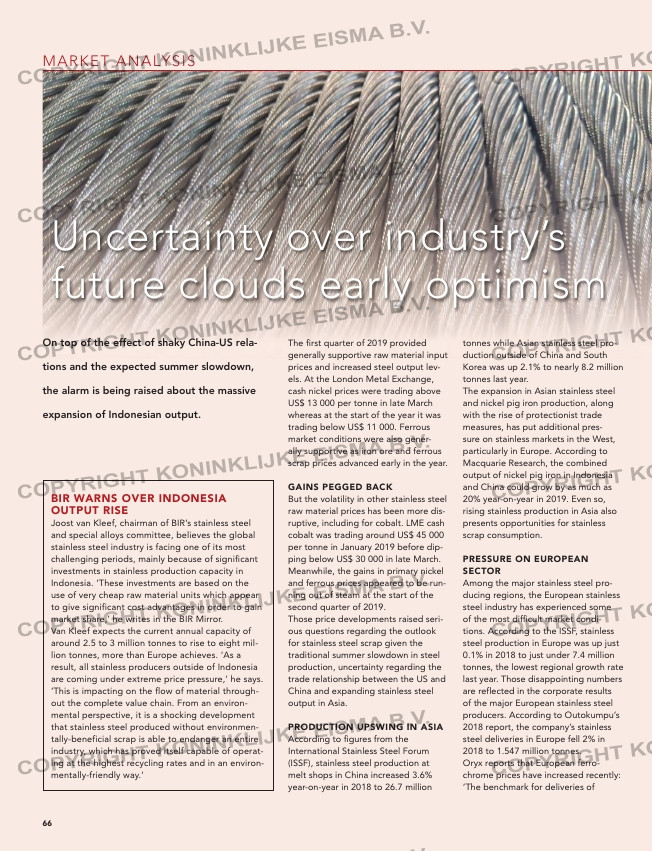Page 66 from: Country report New Zealand and much more!

MARKET ANALYSIS
Uncertainty over industry’s
future clouds early optimism
On top of the effect of shaky China-US rela-
tions and the expected summer slowdown,
the alarm is being raised about the massive
expansion of Indonesian output.
charge and high-carbon ferrochrome
to Europe has risen slightly for the
second quarter of 2019,’ it says. ‘This is
agreed traditionally between a leading
South African ferrochrome producer
and one of the biggest European stain-
less steel producers each quarter. The
benchmark for January to March 2019
was US$ 1.12 per pound, but now is
at US$ 1.20 per pound, an increase of
7.1% over the previous quarter.’
DIRECTION LACKING IN THE US
US stainless and carbon steel produc-
tion has been resilient until recently,
which in turn has been good news for
stainless scrap processors. According
to figures from the ISSF, US stainless
steel melt shop production increased
2% in 2018 to more than 2.8 million
tonnes. Thus far in 2019, figures from
the American Iron and Steel Institute
indicate total domestic steel industry
capacity utilisation rates are running
at 81.9%, up from 76.4% in the corre-
sponding period last year. For stainless
tonnes while Asian stainless steel pro-
duction outside of China and South
Korea was up 2.1% to nearly 8.2 million
tonnes last year.
The expansion in Asian stainless steel
and nickel pig iron production, along
with the rise of protectionist trade
measures, has put additional pres-
sure on stainless markets in the West,
particularly in Europe. According to
Macquarie Research, the combined
output of nickel pig iron in Indonesia
and China could grow by as much as
20% year-on-year in 2019. Even so,
rising stainless production in Asia also
presents opportunities for stainless
scrap consumption.
PRESSURE ON EUROPEAN
SECTOR
Among the major stainless steel pro-
ducing regions, the European stainless
steel industry has experienced some
of the most difficult market condi-
tions. According to the ISSF, stainless
steel production in Europe was up just
0.1% in 2018 to just under 7.4 million
tonnes, the lowest regional growth rate
last year. Those disappointing numbers
are reflected in the corporate results
of the major European stainless steel
producers. According to Outokumpu’s
2018 report, the company’s stainless
steel deliveries in Europe fell 2% in
2018 to 1.547 million tonnes.
Oryx reports that European ferro-
chrome prices have increased recently:
‘The benchmark for deliveries of
66
Reality sinks in
New data by the International Nickel Study Group con-
firms that nickel production was outpacing demand in
Q1/19. There are numerous NPI expansion projects planned in Indonesia.
Also, it’s a fact that almost all existing Ni producers plan increases this
year. On the other hand, Ni demand is expected to go up by only around
3%. It is possible that the Ni market will be in deficit again (for the 4th
year) in 2019, but the deficit will be very small .Thus, the downward price
correction is justified.
BIR WARNS OVER INDONESIA
OUTPUT RISE
Joost van Kleef, chairman of BIR’s stainless steel
and special alloys committee, believes the global
stainless steel industry is facing one of its most
challenging periods, mainly because of significant
investments in stainless production capacity in
Indonesia. ‘These investments are based on the
use of very cheap raw material units which appear
to give significant cost advantages in order to gain
market share,’ he writes in the BIR Mirror.
Van Kleef expects the current annual capacity of
around 2.5 to 3 million tonnes to rise to eight mil-
lion tonnes, more than Europe achieves. ‘As a
result, all stainless producers outside of Indonesia
are coming under extreme price pressure,’ he says.
‘This is impacting on the flow of material through-
out the complete value chain. From an environ-
mental perspective, it is a shocking development
that stainless steel produced without environmen-
tally-beneficial scrap is able to endanger an entire
industry, which has proved itself capable of operat-
ing at the highest recycling rates and in an environ-
mentally-friendly way.’
The first quarter of 2019 provided
generally supportive raw material input
prices and increased steel output lev-
els. At the London Metal Exchange,
cash nickel prices were trading above
US$ 13 000 per tonne in late March
whereas at the start of the year it was
trading below US$ 11 000. Ferrous
market conditions were also gener-
ally supportive as iron ore and ferrous
scrap prices advanced early in the year.
GAINS PEGGED BACK
But the volatility in other stainless steel
raw material prices has been more dis-
ruptive, including for cobalt. LME cash
cobalt was trading around US$ 45 000
per tonne in January 2019 before dip-
ping below US$ 30 000 in late March.
Meanwhile, the gains in primary nickel
and ferrous prices appeared to be run-
ning out of steam at the start of the
second quarter of 2019.
Those price developments raised seri-
ous questions regarding the outlook
for stainless steel scrap given the
traditional summer slowdown in steel
production, uncertainty regarding the
trade relationship between the US and
China and expanding stainless steel
output in Asia.
PRODUCTION UPSWING IN ASIA
According to figures from the
International Stainless Steel Forum
(ISSF), stainless steel production at
melt shops in China increased 3.6%
year-on-year in 2018 to 26.7 million
33,000
29,000
25,000
21,000
17,000
13,000
9,000
5,000
66-67_manickelstainlessadvhksu.indd 66 06-05-19 15:41



